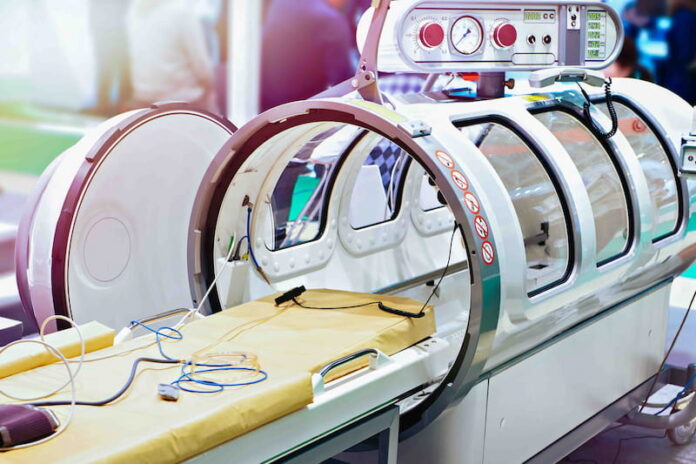Key Takeaways:
– Hyperbaric Oxygen Therapy (HBOT) increases oxygen delivery to the body’s tissues and organs.
– HBOT is a non-invasive treatment that involves breathing in pure oxygen in a pressurized environment.
– The Unconventional HBOT Protocol focuses on individualized treatment plans and integrating complementary therapies.
– HBOT has shown benefits for wound healing, radiation injuries, chronic infections, and neurological disorders.
– Personalized care and patient education are emphasized in the Unconventional HBOT Protocol.
– Success stories include improved quality of life and healing of chronic conditions.
– HBOT treatment involves entering a hyperbaric chamber and breathing in pure oxygen at increased pressure.
– The Unconventional HBOT Protocol utilizes state-of-the-art equipment and techniques to maximize results.
– Ongoing research explores new applications of HBOT, such as traumatic brain injuries and regenerative medicine.
– The Unconventional HBOT Protocol will continue to evolve and adapt with advancements in the field.
The Science Behind HBOT
Hyperbaric Oxygen Therapy (HBOT) is a treatment that involves breathing in pure oxygen in a pressurized environment. This therapy has gained popularity in recent years due to its potential benefits for various medical conditions. The science behind HBOT lies in its ability to increase the amount of oxygen that is delivered to the body’s tissues and organs.
Understanding Hyperbaric Oxygen Therapy (HBOT)
Hyperbaric Oxygen Therapy is a non-invasive treatment that involves the patient entering a chamber and breathing in 100% pure oxygen at a pressure higher than atmospheric pressure. This increased pressure allows the oxygen to dissolve into the bloodstream at a much higher concentration, leading to enhanced oxygen delivery to all parts of the body.
The increased oxygen levels in the body stimulate the release of growth factors and stem cells, promote the formation of new blood vessels, and have anti-inflammatory effects. These mechanisms can have a positive impact on various health conditions, accelerating the healing process, and improving overall well-being.
The History and Evolution of HBOT
The idea of using pressurized chambers to treat medical conditions dates back centuries. The concept of hyperbaric chambers can be traced back to the 1600s when it was first used to treat decompression sickness in divers. Over the years, the technology and understanding of HBOT have evolved, leading to its application in various medical fields.
In the 20th century, HBOT gained recognition as an effective treatment for conditions such as carbon monoxide poisoning and gas gangrene. Since then, research and advancements in technology have expanded the use of HBOT to include conditions like diabetic wounds, radiation injuries, and neurological disorders.
The Benefits of HBOT for Various Conditions
HBOT has shown promising results in the treatment of a wide range of conditions. One of the most well-known applications of HBOT is in wound healing. The increased oxygen delivery to the damaged tissues can promote the formation of new blood vessels, enhance tissue repair, and reduce the risk of infection.
Additionally, HBOT has been used as an adjunctive therapy for conditions such as radiation injuries, chronic infections, traumatic brain injuries, and neurological disorders like multiple sclerosis and stroke. The use of HBOT in these conditions aims to improve oxygenation, reduce inflammation, and support the body’s natural healing processes.
While more research is needed to fully understand the extent of HBOT’s potential benefits, many patients have reported improved symptoms and quality of life after undergoing HBOT treatment.
Breaking the Norms: The Unique HBOT Protocol
The unique HBOT Protocol takes a unique and innovative approach to hyperbaric oxygen therapy. This protocol focuses on individualized treatment plans that take into account each patient’s specific needs and medical history. Rather than following a one-size-fits-all approach, the Unconventional HBOT Protocol tailors the treatment to optimize results for each patient.
Central to this approach is the emphasis on combining HBOT with other complementary therapies, such as nutritional support and lifestyle modifications. By addressing the underlying factors that contribute to a patient’s condition, the Unconventional HBOT Protocol aims to provide holistic and comprehensive care.
The Differences and Advantages of this Protocol
What sets the Unconventional HBOT Protocol apart is its focus on personalized care and the integration of complementary therapies. This approach recognizes that no two patients are the same and that treating the underlying causes of a condition, rather than just the symptoms, can lead to more successful outcomes.
In addition to the customized treatment plans, the Unconventional HBOT Protocol also prioritizes patient education and empowerment. Patients are encouraged to take an active role in their own healing journey and are provided with the resources and support necessary to make informed decisions about their health.
Success Stories and Testimonials from Patients
The Unconventional HBOT Protocol has garnered praise from many patients who have experienced its benefits firsthand. Stories of improved quality of life, reduced symptoms, and enhanced well-being are common among those who have undergone this unique approach.
One patient, John, suffered from chronic fatigue syndrome for years. Traditional treatments had provided limited relief, but after undergoing the Unconventional HBOT Protocol, he experienced a significant decrease in his symptoms and a newfound energy and vitality. He credits the personalized treatment plan and the integration of lifestyle changes as key factors in his recovery.
Another patient, Sarah, had been living with a non-healing wound for several months. After trying various conventional treatments without success, she turned to the Unconventional HBOT Protocol. Through a combination of hyperbaric oxygen therapy, nutritional support, and wound care techniques, her wound finally healed, and she was able to resume her normal activities.
The Unconventional Treatment Process
Step-by-Step Guide to the HBOT Protocol
The Unconventional HBOT Protocol follows a step-by-step approach to ensure optimal results for patients. The treatment process begins with a comprehensive evaluation of the patient’s medical history, symptoms, and goals. This evaluation allows the healthcare team to design a personalized treatment plan tailored to the patient’s specific needs.
The actual HBOT treatment involves the patient entering a hyperbaric chamber and breathing in 100% pure oxygen at an increased pressure. The chambers are designed to be comfortable and spacious, allowing patients to relax during the treatment session, which typically lasts for about one hour.
Throughout the treatment process, regular follow-up evaluations are conducted to monitor progress and make any necessary adjustments to the treatment plan. This ongoing assessment ensures that the patient is receiving the most effective and beneficial treatment possible.
Understanding the Specialized Equipment and Techniques Used
The Unconventional HBOT Protocol utilizes state-of-the-art equipment and techniques to deliver the highest standard of care. The hyperbaric chambers are designed with patient comfort in mind, providing a relaxed and spacious environment for treatment sessions.
Additionally, the Unconventional HBOT Protocol may incorporate other specialized equipment, such as wound care devices, nutritional supplements, and exercise programs. These additional tools and techniques work synergistically with HBOT to enhance the overall treatment outcomes.
How the Unconventional Approach Maximizes Results
The Unconventional HBOT Protocol maximizes results by taking a comprehensive and individualized approach to patient care. By addressing the underlying factors contributing to a patient’s condition and utilizing a combination of therapies, the protocol aims to optimize healing and overall well-being.
Furthermore, the emphasis on patient education and empowerment ensures that patients are active participants in their own healing journey. Understanding the rationale behind the treatment plan and making informed decisions about their health can increase patient compliance and improve treatment outcomes.
The Future of HBOT: Advancements and Innovations
The Latest Research and Breakthroughs in HBOT
HBOT is a field of ongoing research and innovation. Scientists and medical professionals are continually exploring new applications and potential benefits of this therapy.
Recent studies have shown promising results in using HBOT for conditions such as traumatic brain injuries, autism spectrum disorders, and chronic neurological conditions. Researchers are also investigating the potential use of HBOT in the field of regenerative medicine, aiming to harness its healing properties for tissue repair and regeneration.
Potential Applications and New Areas of Study
As the understanding of HBOT continues to evolve, researchers are exploring its potential applications in various medical fields. Some areas of study include the use of HBOT for cancer treatment, sports-related injuries, and age-related cognitive decline. Preliminary findings show exciting possibilities for expanding the use of HBOT in the future.
What the Future Holds for the Unconventional HBOT Protocol
The future of the Unconventional HBOT Protocol is bright, with ongoing research and advancements in the field of hyperbaric medicine. The protocol will continue to evolve and adapt as new findings emerge, ensuring that patients receive the most effective and innovative treatments available.
Ultimately, the goal of the Unconventional HBOT Protocol is to provide patients with a comprehensive and personalized approach to healing, empowering them to take control of their health and improve their quality of life.
Did you find this helpful? Check out our other helpful articles on our website.
Read Also
- Why the Keto Diet Works for Some People—and Fails Dramatically for Others: An Ayurvedic Breakdown for Modern HealthcareThe keto diet has dominated weight-loss culture for years. For some people, it produces rapid fat loss, stable energy, and improved mental clarity. For others—especially those who gain weight easily—it leads to burnout, digestive distress, rebound weight gain, high cholesterol, and a metabolism that feels slower than before. Healthcare often frames this as a discipline… Read more: Why the Keto Diet Works for Some People—and Fails Dramatically for Others: An Ayurvedic Breakdown for Modern Healthcare
- How to Choose the Best Assisted Living Facility for SeniorsAre you looking for the right assisted living facility for a senior loved one? Choosing a place can feel overwhelming. There are many factors to consider, from care services to the environment. Safety, comfort, and social opportunities play important roles in daily life. Each senior has unique needs and preferences that must be met. Understanding… Read more: How to Choose the Best Assisted Living Facility for Seniors
- Burn Smart, Not Hard; Shape Burn: Clean Protein for Weight ManagementYou want to feel light, strong, and confident. You don’t want crash diets or fake promises. You need a plan that works with your body, not against it. That’s where Shape Burn comes in. You can burn fat without losing strength. You can eat better and stay full. You can manage weight in a way… Read more: Burn Smart, Not Hard; Shape Burn: Clean Protein for Weight Management
- Creatine Basics: How Much Is 5g, How Much Water You Need, and Whether Pills or Powder Work BetterIf you’ve ever walked into a supplement aisle or scrolled through fitness TikTok, you’ve probably seen people talking about creatine — usually with a shaker bottle in hand and promises of better workouts and faster gains. And honestly? They’re not wrong. Creatine is one of the most researched and effective supplements for muscle strength, recovery,… Read more: Creatine Basics: How Much Is 5g, How Much Water You Need, and Whether Pills or Powder Work Better
- Understanding Breast Cancer in Men: Key Facts and SymptomsBreast cancer is often thought of as a disease that only affects women. However, men can develop it too. Although it is less common, early detection and awareness are important. Read on to learn key facts, symptoms, and ways men can take action to protect their health. How Common Is Breast Cancer in Men? Breast… Read more: Understanding Breast Cancer in Men: Key Facts and Symptoms
- Raising Awareness: Breast Cancer Facts for Older MenBreast cancer does not affect only women, and many older men do not realize they are at risk. Because the signs can be easy to miss, many men learn about the disease only when it has progressed. Learning the basic facts now can help you stay aware and respond early. If you want to protect… Read more: Raising Awareness: Breast Cancer Facts for Older Men
- How Regular Exercise Transforms Senior Living for the BetterGetting older is something everyone experiences, but how we age can be greatly influenced by the choices we make. One of the best ways for seniors to stay healthy, happy, and independent is through regular exercise. Staying active isn’t just about fitness-it can improve nearly every part of life. From building strength and energy to… Read more: How Regular Exercise Transforms Senior Living for the Better
- The Importance of Mammograms and Early Detection for Aging WomenAs women age, taking care of their health becomes even more important. One key part of women’s health is regular breast screenings. Mammograms are a simple but powerful tool that can detect breast changes early. Early detection can save lives by finding problems before they become serious. For aging women, staying informed and proactive about… Read more: The Importance of Mammograms and Early Detection for Aging Women









